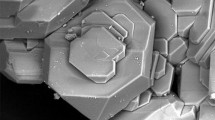Abstract
Raman spectra were obtained for single- and polycrystalline specimens of some oxide compounds used as quantum electronic materials and for native minerals containing complex anions, where the cations are alkaline-earth metals and lead. An analysis of the low-frequency regions of the Raman spectra showed that, in some cases, the pair of high-intensity lines appearing in the range below 100 cm–1 serves as an indicator of the presence of Pb2+ ions.




Similar content being viewed by others
REFERENCES
D. Bersani and J. M. Madariaga, J. Raman Spectrosc. 43, 1523 (2012). https://doi.org/10.1002/jrs.4219
D. Yang and Y. Ying, Appl. Spectrosc. Rev. 46, 539 (2011). https://doi.org/10.1080/05704928.2011.593216
T. T. Basiev, Phys.-Usp. 42, 1051 (1999). https://doi.org/10.1070/PU1999v042n10ABEH000663
L. I. Ivleva, I. S. Voronina, P. A. Lykov, et al., J. Cryst. Growth 304, 108 (2007). https://doi.org/10.1016/j.jcrysgro.2007.02.020
H. Poulet and J. P. Mathieu, Spectres de Vibration et Symetrie des Cristaux (Gordon & Breach, 1970; Mir, Moscow, 1973).
G. E. Kugel, F. Brehat, B. Wyncke, et al., J. Phys. C: Solid State Phys. 21, 5565 (1988). https://doi.org/10.1088/0022-3719/21/32/011
Yu. K. Voron’ko and A. A. Sobol’, Inorg. Mater. 41, 420 (2005).
A. H. Pandey, V. Sathe, and S. M. Gupta, Proceedings of the National Laser Symposium (NLS-2015).
N. Waeselmann, B. Mihailova, M. Gospodinov, and U. Bismayer, J. Phys.: Condens. Matter 25, 155 902 (2013). https://doi.org/10.1088/0953-8984/25/15/155902
A. G. Souza Filho et al., J. Phys.: Condens. Matter 13, 7305 (2001).
Yu. K. Voron’ko, B. F. Dzhurinskii, A. E. Kokh, et al., Inorg. Mater. 41, 984 (2005).
R. Frost and P. Williams, Spectrochim. Acta A 60 (8–9), 207 (2004). https://doi.org/10.1016/j.saa.2003.11.007
A. Rulmont, Spectrochim. Acta A 34, 1117 (1978).
ACKNOWLEDGMENTS
The authors are greatly thankful to L.I. Ivleva for providing barium tungstate single-crystal specimens.
Funding
This study was supported by the Russian Foundation for Basic Research (project No. 17-02-00518).
Author information
Authors and Affiliations
Corresponding author
Additional information
Translated by O. Fedorova
Rights and permissions
About this article
Cite this article
Shukshin, V.E., Fedorov, P.P. & Generalov, M.E. Low-Frequency Raman Lines as an Indicator of the Presence of Lead in Oxide Materials. Russ. J. Inorg. Chem. 64, 1442–1445 (2019). https://doi.org/10.1134/S0036023619100140
Received:
Revised:
Accepted:
Published:
Issue Date:
DOI: https://doi.org/10.1134/S0036023619100140




